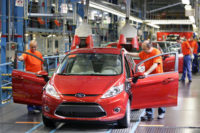“Service Robots” Hit Double Digit Growth Worldwide

FRANKFURT, Germany—The market for professional service robots reached a turnover of $6.7 billion worldwide, a 12 percent increase from 2020, according to the "World Robotics 2021–Service Robots" report by the International Federation of Robotics. At the same time, turnover of new consumer service robots grew 16 percent to $4.4 billion.
“Service robots continued on a successful path proving the tremendous market potential worldwide,” says IFR President Milton Guerry. “Sales of professional service robots rose an impressive 41 percent to 131,800 units in 2020.”
One out of three units were built for the transportation of goods or cargo. Turnover for Autonomous Mobile Robots (AMR) and delivery robots grew by 11 percent to more than $1 billion. Most units sold operate in indoor environments for production and warehouses. The trend goes towards flexible solutions, so that the AMR´s act in mixed environments together e.g. with forklifts, other mobile robots or humans. There is also a strong market potential for transportation robots in outdoor environments with public traffic, e.g. lastmile delivery. Marketing and monetarization options will depend on the availability of regulatory frameworks which currently still prevent the large-scale deployment of such robots in most countries.
Demand for professional cleaning robots grew by 92 percent to 34,400 units sold. In response to increasing hygiene requirements due to the Covid-19 pandemic, more than 50 service robot providers developed disinfection robots, spraying disinfectant fluids, or using ultraviolet light. Often, existing mobile robots were modified to serve as disinfection robots. There is a high ongoing potential for disinfection robots in hospitals and other public places. Unit sales of professional floor cleaning robots are expected to grow by double-digit rates on average each year from 2021 to 2024.
In terms of value, the sales of medical robotics accounts for 55 percent of the total professional service robot turnover in 2020. This was mainly driven by robotic surgery devices, which are the most expensive type in the segment. Turnover increased by 11 percent to $3.6 billion. A tremendously growing number of robots for rehabilitation and non-invasive therapy make this application the largest medical one in terms of units. About 75 percent of medical robot suppliers are from North America and Europe.
Hospitality robots enjoy growing popularity generating turnover of $249 million. Demand for robots for food and drink preparation grew tremendously, as turnover almost tripled to $32 million, an increase of 196 percent. The pandemic created increased awareness to avoid contact with food products. There is still a huge potential for hospitality robots with medium double-digit annual growth predicted.
Robots for domestic tasks are the largest group of consumer robots. Almost 18.5 million units (+6 percent), worth $4.3 billion, were sold in 2020.
Robot vacuums and other robots for indoor domestic floor cleaning were up 5% to more than 17.2 million units with a value of $2.4 billion. This kind of service robot is available in convenience stores, making it easily accessible for everyone.
Gardening robots usually comprise lawn mowing robots. This market is expected to grow by low double-digit growth rates on average each year in the next few years.
Looking for a reprint of this article?
From high-res PDFs to custom plaques, order your copy today!





